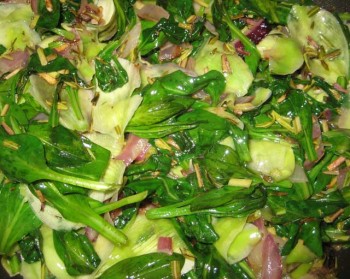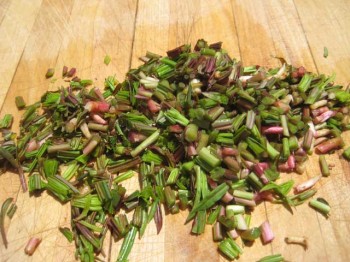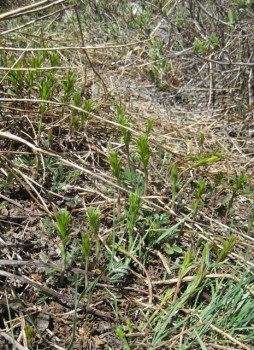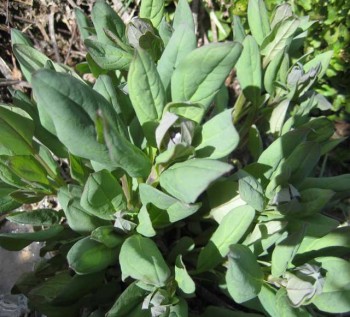
Yesterday I experienced the somewhat unique problem of having too many bags of wild edible plants in my refrigerator and not enough “normal” food with which to make lunch. So I improvised—and it worked out surprisingly well.
When In Doubt, Stir Fry
My most successful stir fry in recent months, then, involved sautéing finely chopped red onions and fireweed shoots for 10 minutes in olive oil, then adding yucca petals and Mertensia leaves, sautéing for another 5 minutes, and serving with noodles.
Normally I add a sauce to my stir fries, but this time I didn’t season it at all. Yucca was the dominant flavor, followed by the onions and olive oil. The fireweed shoots made for a nice, crispy texture, and although the Mertensia leaves lost the mild oyster-like flavor they have when raw, upon cooking they turned a beautiful bright green that made the dish look fantastic.
Here are some more details on the wild ingredients:

Chopping Fireweed Shoots Increases Palatability
I’ve been eating fireweed (Epilobium angustifolium) for the past two years, but despite my initial excitement over it, I have to admit I haven’t had much success making it very palatable.
“Eat your greens!” I scolded Gregg one night after I spied him surreptitiously pushing his Epilobium to the side of the plate.
I forage the young fireweed shoots and underdeveloped leaves, per Gregory Tilford’s Edible and Medicinal Plants of the West (1997). “At the early stages of growth, when young leaves are pointed upward along the stems, the entire plant can be snapped off at ground-level and enjoyed like young asparagus,” he writes.

Steam and steam as I may, however, I never seem to get anything reminiscent of asparagus. Perhaps I’m steaming it for too long, since the shoots seem fairly tender early on and then get tougher the longer I cook them.
This time, however, I left the water out of the equation and went straight to sautéing the fireweed shoots in oil, and that seemed to work well. The other thing I did differently was to chop the shoots into fine pieces. That, above all, may have been the ticket—so based on this realization here’s another maxim for you: When in doubt, chop into itty bitty pieces!
Mertensia is a Genus of Bluebells
Mertensia is the genus of plants commonly referred to as “bluebells.” There are other genera that share the same common name, however, so please take your plant identification seriously and cross-reference guides or consult an expert if you have any doubts. This website is NOT an identification guide. This entry IS about Mertensia and no other plant called by the name “bluebells.”
The first time I ate and wrote about Mertensia, I could only find one reference to its edibility in my wild food book collection. In Edible and Medicinal Plants of the West, Tilford invites us to snack on the raw leaves, which have a “mild but distinct oysterlike flavor,” before concluding that they “lend themselves best to a good stir-fry dish.” He cautions, however, that Mertensia may contain “alkaloids and other constituents that can be toxic if consumed in large quantities.”

Since then I’ve found one additional print reference (as well as several online references) to the edibility of Mertensia. “Tall bluebells [M. paniculata] can be used as a potherb, but it is a bit too hairy for salads,” write Kershaw et. al. in The Lone Pine Field Guide to Plants of the Rocky Mountains (1998).
Mertensia species are many. At high altitude I’ve seen low bluebells growing in dry areas and taller species that prefer wet areas. The small ones almost don’t seem worth foraging on account of low yield, but the tall ones have plentiful leaves. Different guides describe both M. paniculata and M. ciliata, two species of tall bluebells, as “hairy,” but the bluebells I’ve been eating are not hairy.
I’ve experimented with Mertensia only a handful of times—tentatively at first, in part because of the sparse edibility references I’ve found to date. I started with one leaf, graduated to a handful of leaves, and this time I used probably 2 cups of leaves, split between two people. As I’ve become accustomed to this plant over the past two years, I am now capable of identifying it prior to flowering, which is when I collected the leaves for this particular stir fry.
Flavorful Yucca Petals
The third wild plant I added to yesterday’s stir fry was yucca (Yucca spp). I’ve been beating a dead horse with yucca of late, however, so if you are interested, please see Aurora Yucca and the Recipes I’ve Tried With It, Yucca in My Pantry Again, and the most recent entry, Southwestern Fried Yucca Flowers—Just What the Doctor Ordered?
Experienced Users Only
Combining multiple wild edible plants into a single dish is an advanced art. When you eat multiple wild edibles at one sitting, particularly ones with which you are unfamiliar, you have no way of knowing which plant is responsible for any effect you may feel. The safest bet is to familiarize yourself with each new plant individually before going gaga on a wild combo platter—which is why the above recipe is for experienced users only.

Leave a Reply